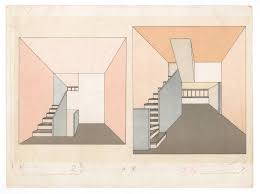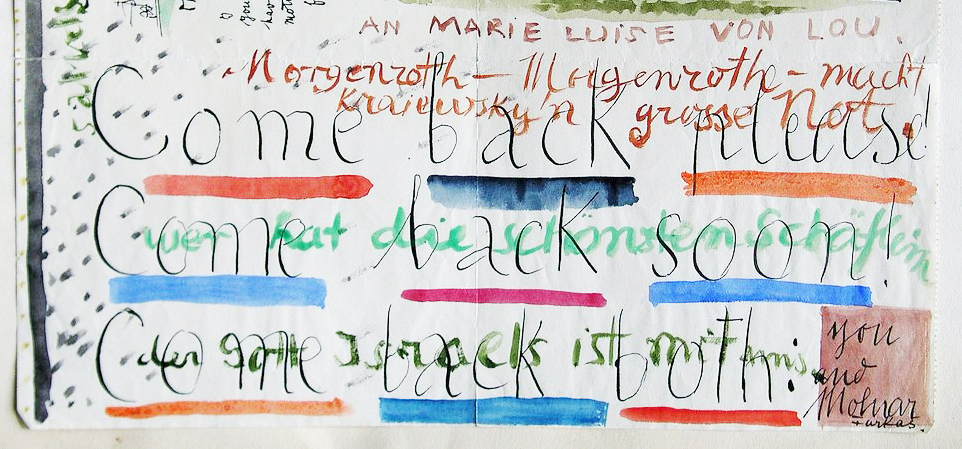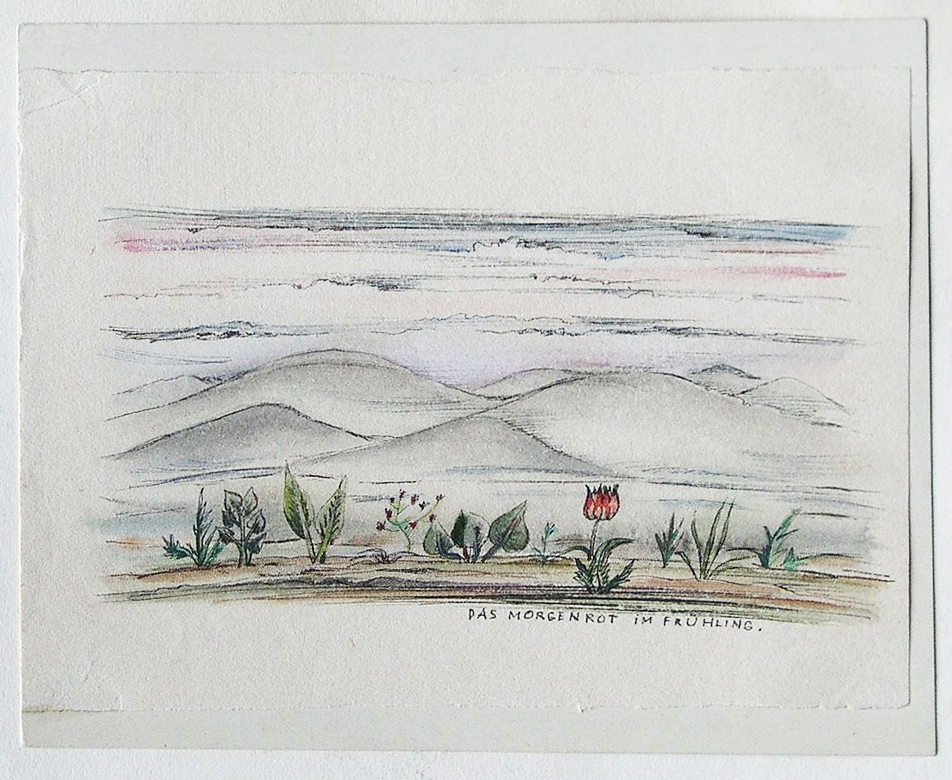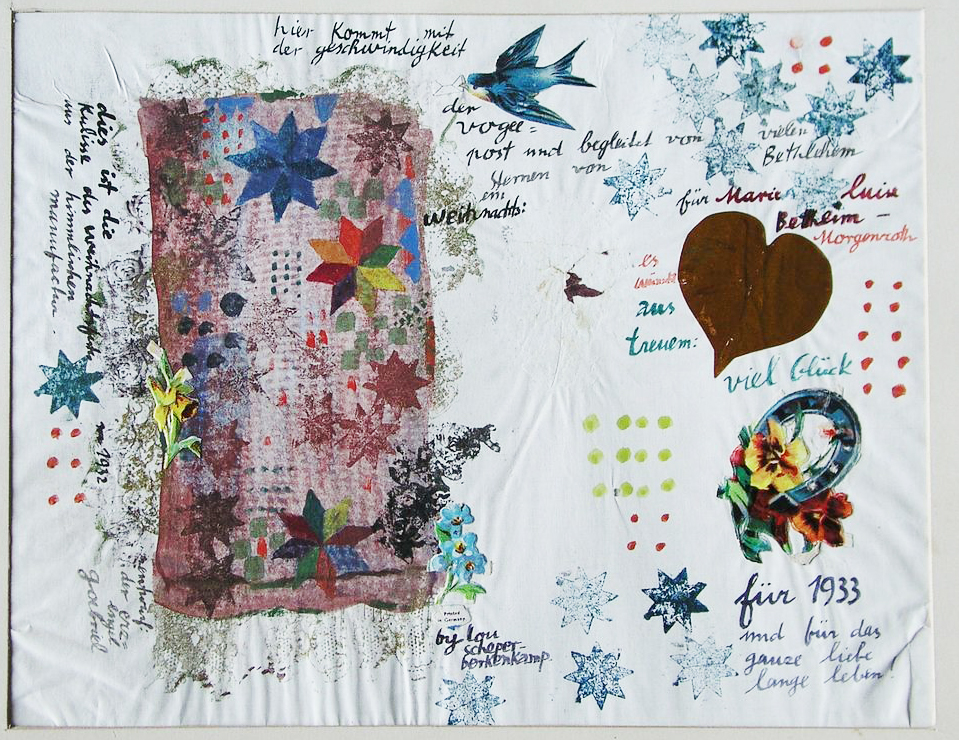WOMEN AT THE BAUHAUS
LOU SCHEPER-BERKENKAMP
(1901–1976)
Born in Wesel, Germany
Grammar school/school graduation abitur
1920
Bauhaus Weimar
Mural painting workshop
1922 she marries Hinnerk Scheper
The couple leaves the bauhaus
First picture letters »Phantastiken«
1925
Hinnerk Scheper becomes master of the mural painting workshop at the Bauhaus Dessau
1927 they move into a master house.
Lou Scheper-Berkenkamp works in Oskar Schlemmer's stage workshop, especially in costume and stage design, but also direction.
1929–1931
Stays in Moscow, focus on colour design; text contributions for the »Moskauer Rundschau«
From 1933 free artist in Berlin
As of 1948
Publication of children's books by Ernst Wunderlich, Leipzig
1951–1970
Member of the board of the Berlin art association »Der Ring«
1956-1969 Co-responsible for the design of the great Berlin art exhibition
After her husband's death in 1957 she took over his colour design work in the Berlin architecture scene
Children's home, Otto Bartning
Berlin Philharmonic, Hans Scharoun
Berlin State Library, Hans Scharoun
Buildings by Walter Gropius
Berlin Tegel Airport building
PHANTASTIKEN
Lou Scheper-Berkenkamp, 1922
»Phantastiken« – this word creation by Lou Scheper-Berkenkamp can be used to mark most of her very different works of art: her descriptions of imaginary world journeys to fantastic countries, her picture sheets leading to heavenly realms, her children's books in which incredible adventures are told, but also many of her colourful pictures of the post-war period, which only appear naturalistic at first glance. These are fantasies of a »Bauhäusler« that became possible because, in addition to systematic investigations into function, colour, form and material, the Bauhaus - in Lou Scheper's own words - »carefully cultivated the creative qualities of imaginative personalities and took games seriously«. [...]
Lou Scheper-Berkenkamp not only witnessed the founding years of the Weimar Bauhaus, where she was a student of Lyonel Feiniger, Paul Klee and Georg Muche between 1920 and 1922 and where she studied at the workshop for mural painting, but later also worked at the stage workshop directed by Oskar Schlemmer at the Bauhaus Dessau. Her husband, Hinnerk Scheper, had been appointed in 1925 as head of the workshop for mural painting. Her early artistic works are clearly influenced by various Bauhaus masters, above all Paul Klee, and show her desire, already then and later, to make dream worlds visible
From 1922 onwards, she began to delight her friends with imaginative, humorous »picture letters« in which her talent for language also became visible. They are mainly congratulations and wishes for recovery, also travel greetings, in which, in addition to coloured drawings – sometimes also collages – the typeface is an essential design feature.
Fascinated since childhood by the atmosphere of fairgrounds, the circus world and the theatre, and inspired by her work at the Bauhaus stage and a three-month stay in Ascona, she painted pictures from these areas, which in the weightlessness of some figures are reminiscent of works by Marc Chagall, while others, due to changing perspectives and the statics of the persons, are more reminiscent of naive painting.
Between 1929 and 1931, her life at the Bauhaus was interrupted by two longer stays in Moscow, where her husband had been appointed as a specialist for colour in architecture. She supported him in his manifold tasks and wrote critical commentaries on cultural events for the German-language Moskauer Rundschau. In addition, she made expressive ink sketches of people in Moscow's streets, which she later partially developed into pictures with groups of people with caricaturally depicted faces in unusual detail. In the process, as well as in various paintings and later works, experiments with colour and the application to the surface of the picture prove her knowledge acquired in mural painting.
»We painted and sprayed in teamwork [...] with lust and a guilty conscience, because we were aware that our actions were completely unfunctional.«
Lou Scheper-Berkenkamp
”
»There is little in the architecture and art of our time that has not been felt, pre-formulated or anticipated at the Bauhaus, even though it rarely seems to have been completed, or even thought through to the end. A fragment, no doubt, this our now already legendary Bauhaus, transfigured by the charm of the unfinished.«
Lou Scheper, Review 1971
Lou Scheper-Berkenkamp, untitled, late 1930s. Source McNay Museum
Lou Scheper also gave free rein to her imagination in inventing bizarre creatures, ghosts and spectres, which she drew with a fine pen and coloured with restraint and a proposal to nature to standardize and create a collapsible, two-dimensional human type. She sent her children similarly designed sheets of paper with figures from the circus and funfair and names containing puns that they probably could not yet understand. She also drew them the picture book of »Jan and Jon«, who embarked on an adventure journey by ship - a theme that Lou Scheper took up again in 1946/47, varied and developed into a children's book. It was published - together with three other small picture stories - in 1948.
With her imaginative, unsentimental and only to a limited extent instructive children's books, she created a genre in which word and image form a unity - similar to her »picture letters«, which she was able to show in the same year at her first solo exhibition in Rudolstadt under the title »Airmail of the Blessed«. The humorous signatures each explain an associated drawing in which heavenly and earthly beings from the most diverse epochs come together, creating a surprising confusion. As a mediator between this world and the next, she considered »birds and other winged creatures«, which she mainly depicted in meticulously dotted, black and white pen and ink drawings.
In addition to these works, she has painted many pictures since the 1950s that at first glance appear naturalistic. One sees abandoned houses in deserted streets bathed in diffuse light that look like backdrops. Lonely beaches with architectural relics and shipwrecks could represent the end of the world, were it not for the delicate, crystalline formations in the sky, which either refer to extraterrestrial realms or are intended to awaken hope for a better world. Lou Scheper thus revives the longings of romanticism and succeeds in inspiring the viewer to make his own interpretations. Many of these works were shown at exhibitions in the post-war period - above all in Berlin, where the family had moved in 1934 and where Hinnerk Scheper was appointed state curator immediately after the end of the war.
Lou Scheper was soon able to participate in the revival of the exhibition system in Berlin, in addition to managing the household, looking after her three children and cultivating a growing circle of friends. She joined the Professional Association of Visual Artists, became a member of its board of directors and supervised the Great Berlin Art Exhibition which is usually held annually. After the early death of her husband in 1957, she returned to architectural colour design, for example in Hans Scharoun's Berlin Philharmonic Hall and in the all-day school with kindergarten designed by Walter Gropius in Berlin-Rudow. Her colour design in the Berlin State Library was not yet finished when she died unexpectedly in April 1976.
Renate Scheper
Phantastiken, Bauhaus-Archiv, Exhibition 2012–2013 Source: MuseumsJournal 4/2012


Phantastiken: The Bauhäusler Lou Scheper-Berkenkamp - Folder Bauhaus Archive. Source: www.vordemberge-gildewart.de
PHANTASTIKEN
WOMEN AT THE BAUHAUS
LOU SCHEPER-BERKENKAMP
(1901–1976)
1901 Born in Wesel, Germany
Grammar school/school graduation Abitur
1920
Bauhaus Weimar
Mural painting workshop
1922 she marries Hinnerk Scheper
The couple leaves the bauhaus
First picture letters »Phantastiken«
1925
Hinnerk Scheper becomes master of the mural painting workshop at the Bauhaus Dessau
1927 they move into a master house
Lou Scheper-Berkenkamp works in Oskar Schlemmer's stage workshop, especially in costume and stage design
1929–1931
Stays in Moscow, focus on colour design; text contributions for the »Moskauer Rundschau«
From 1933 free artist in Berlin
As of 1948
publication of children's books by Ernst Wunderlich, Leipzig
1951–1970
Member of the board of the Berlin art association »Der Ring«
1956-1969 co-responsible for the design of the great berlin art exhibition
After her husband's death in 1957 she took over his colour design work in the Berlin architecture scene
Children's home, Otto Bartning
Berlin philharmonic, Hans Scharoun
Berlin state library, Hans Scharoun
Buildings by walter gropius
Berlin Tegel airport building
»There is little in the architecture and art of our time that has not been felt, pre-formulated or anticipated at the Bauhaus, even though it rarely seems to have been completed, or even thought through to the end. A fragment, no doubt, this our now already legendary Bauhaus, transfigured by the charm of the unfinished.«
Lou Scheper, Review 1971
»Phantastiken« – this word creation by Lou Scheper-Berkenkamp can be used to mark most of her very different works of art: her descriptions of imaginary world journeys to fantastic countries, her picture sheets leading to heavenly realms, her children's books in which incredible adventures are told, but also many of her colourful pictures of the post-war period, which only appear naturalistic at first glance. These are fantasies of a »Bauhäusler« that became possible because, in addition to systematic investigations into function, colour, form and material, the Bauhaus - in Lou Scheper's own words - »carefully cultivated the creative qualities of imaginative personalities and took games seriously«. [...]
Lou Scheper-Berkenkamp not only witnessed the founding years of the Weimar Bauhaus, where she was a student of Lyonel Feiniger, Paul Klee and Georg Muche between 1920 and 1922 and where she studied at the workshop for mural painting, but later also worked at the stage workshop directed by Oskar Schlemmer at the Bauhaus Dessau. Her husband, Hinnerk Scheper, had been appointed in 1925 as head of the workshop for mural painting. Her early artistic works are clearly influenced by various Bauhaus masters, above all Paul Klee, and show her desire, already then and later, to make dream worlds visible.
From 1922 onwards, she began to delight her friends with imaginative, humorous »picture letters« in which her talent for language also became visible. They are mainly congratulations and wishes for recovery, also travel greetings, in which, in addition to coloured drawings – sometimes also collages – the typeface is an essential design feature.
Fascinated since childhood by the atmosphere of fairgrounds, the circus world and the theatre, and inspired by her work at the Bauhaus stage and a three-month stay in Ascona, she painted pictures from these areas, which in the weightlessness of some figures are reminiscent of works by Marc Chagall, while others, due to changing perspectives and the statics of the persons, are more reminiscent of naive painting.
Between 1929 and 1931, her life at the Bauhaus was interrupted by two longer stays in Moscow, where her husband had been appointed as a specialist for colour in architecture. She supported him in his manifold tasks and wrote critical commentaries on cultural events for the German-language Moskauer Rundschau. In addition, she made expressive ink sketches of people in Moscow's streets, which she later partially developed into pictures with groups of people with caricaturally depicted faces in unusual detail. In the process, as well as in various paintings and later works, experiments with colour and the application to the surface of the picture prove her knowledge acquired in mural painting.
Lou Scheper also gave free rein to her imagination in inventing bizarre creatures, ghosts and spectres, which she drew with a fine pen and coloured with restraint and a proposal to nature to standardize and create a collapsible, two-dimensional human type. She sent her children similarly designed sheets of paper with figures from the circus and funfair and names containing puns that they probably could not yet understand. She also drew them the picture book of »Jan and Jon«, who embarked on an adventure journey by ship - a theme that Lou Scheper took up again in 1946/47, varied and developed into a children's book. It was published - together with three other small picture stories - in 1948.
With her imaginative, unsentimental and only to a limited extent instructive children's books, she created a genre in which word and image form a unity - similar to her »picture letters«, which she was able to show in the same year at her first solo exhibition in Rudolstadt under the title »Airmail of the Blessed«. The humorous signatures each explain an associated drawing in which heavenly and earthly beings from the most diverse epochs come together, creating a surprising confusion. As a mediator between this world and the next, she considered »birds and other winged creatures«, which she mainly depicted in meticulously dotted, black and white pen and ink drawings.
In addition to these works, she has painted many pictures since the 1950s that at first glance appear naturalistic. One sees abandoned houses in deserted streets bathed in diffuse light that look like backdrops. Lonely beaches with architectural relics and shipwrecks could represent the end of the world, were it not for the delicate, crystalline formations in the sky, which either refer to extraterrestrial realms or are intended to awaken hope for a better world. Lou Scheper thus revives the longings of romanticism and succeeds in inspiring the viewer to make his own interpretations. Many of these works were shown at exhibitions in the post-war period - above all in Berlin, where the family had moved in 1934 and where Hinnerk Scheper was appointed state curator immediately after the end of the war.
Lou Scheper was soon able to participate in the revival of the exhibition system in Berlin, in addition to managing the household, looking after her three children and cultivating a growing circle of friends. She joined the Professional Association of Visual Artists, became a member of its board of directors and supervised the Great Berlin Art Exhibition which is usually held annually. After the early death of her husband in 1957, she returned to architectural colour design, for example in Hans Scharoun's Berlin Philharmonic Hall and in the all-day school with kindergarten designed by Walter Gropius in Berlin-Rudow. Her colour design in the Berlin State Library was not yet finished when she died unexpectedly in April 1976.
Renate Scheper
Phantastiken, Bauhaus-Archiv, Exhibition 2012–2013 Source: MuseumsJournal 4/2012
Phantastiken: The Bauhäusler Lou Scheper-Berkenkamp - Folder Bauhaus Archive. Source: www.vordemberge-gildewart.de
»We painted and sprayed in teamwork [...] with lust and a guilty conscience, because we were aware that our actions were completely unfunctional.«
Lou Scheper-Berkenkamp
Letters to Marie-Luise Betlheim 1922–1936
Marie-Luise Betlheim (née Morgenroth) lived in Weimar in her youth and had lively contact with the students and teachers of the Bauhaus. The correspondence testifies to the friendship between the two women.
Marie-Luise Betlheim ans Lou Scheper-Berkenkamp. Collection Marie-Luise Betlheim, MSU Zagreb | © Nachlass Scheper
Source: www.jutarnji.hr

Lou for Marie-Luise :
Roses, tulips, carnations,
all three will wither
Marble, steel, and iron will break
But not our friendship!
Our friendship will remain
Until we are laid to rest.


